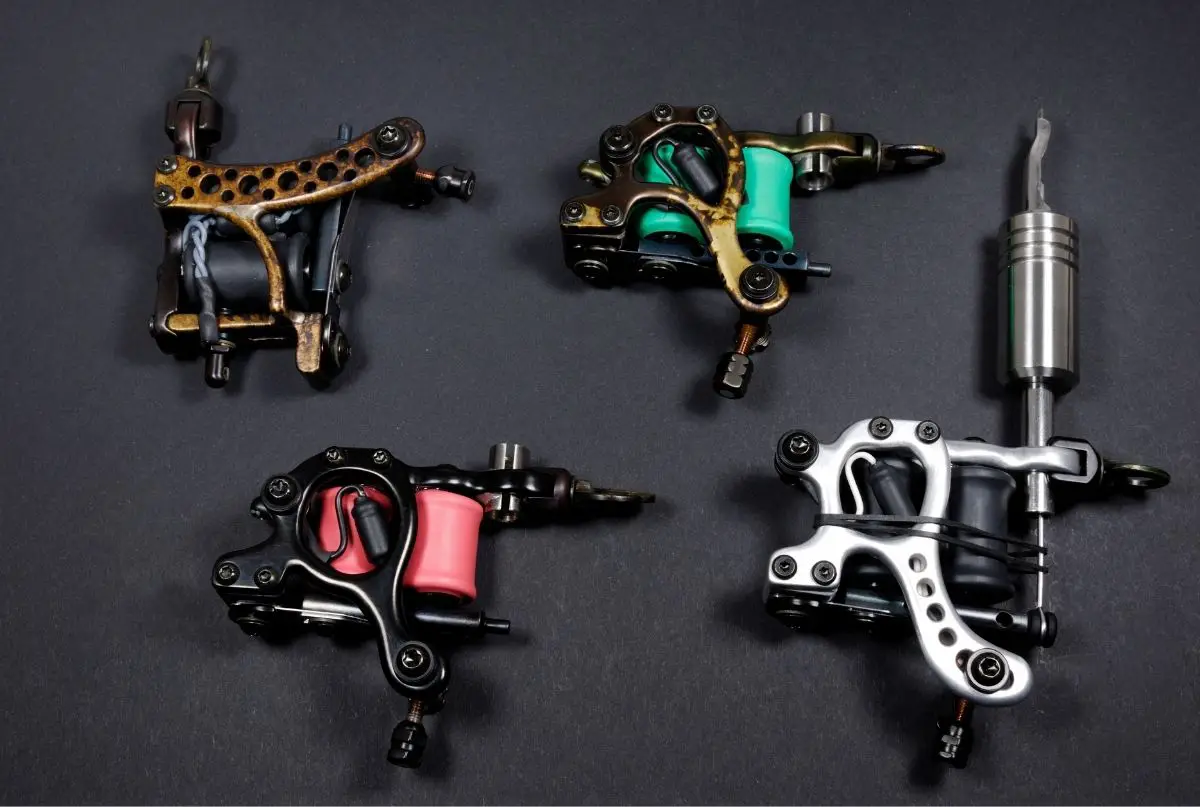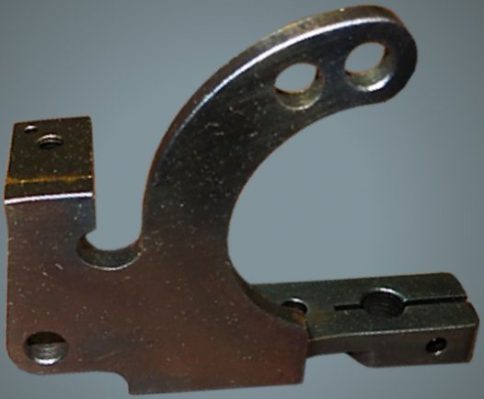Different Types of Tattoo Machines: What’s New in 2023
As an Amazon Associate, we earn commissions on qualifying purchases (at no extra cost to you).
Quality tattoo work starts with a quality machine. Since it greatly affects the process and outcome, it’s imperative to look for the right types of tattoo machines that suit your preferences.
Of all tattoo supplies, the machine is likely the one that costs the most money. While affordable choices exist, investing in a high-end model is the right decision to ensure customer satisfaction.
Happy clients will love to contact you again if they feel content with their first project.
Broadly speaking, tattoo machines are grouped into 3 major categories by how they work, namely liners, shaders, and color packers.
Liners are designed for creating fine lines and outlining the shape of a tattoo. They work quickly and accurately but do not penetrate the skin as deeply as other types of machines.
Shaders, on the other hand, are used for filling in colors and creating shading effects. With a longer armature bar, shaders can achieve various gradients and provide a smoother color transition.
Color packers, similar to shaders, are used for filling in colors and black ink. They strike harder and penetrate deeper into the skin, making them suitable for solid-color fillings but not ideal for grayscale or shading gradients.
If you want to learn more about the different kinds of tattoo machines, keep reading. We’ll go into more detail with examples and pictures of each type.
Related: Tattoo Pen Machines | Rotary Tattoo Machines | Coil Tattoo Machines | Liner Tattoo Machines | Tattoo Power Supply
History of Tattoo Machines
The engraving symbols on the skin were done using tools derived from nature, such as soot and ash.
Tattoo guns weren’t a thing back then, so something with a pointy tip was needed, like a bone to puncture the skin.
This made the tattooing process unsanitary and painful since no numbing cream was involved.
That gradually changed with the invention of the first rotary machine by Thomas Edison in 1876. And in 1891, an electronic version of that was introduced by Samuel O’Reilly.
It took the world by storm, but unfortunately, the bulky design hindered its full potential.
Following years of consistent improvements, Percy Waters, hailed by many as the forefather of modern tattooing, came up with a brilliant idea, a machine comprised of electromagnetic coils or simply known as coil machines.
He created 14 different styles of that invention and managed to secure a patent for the work.
Well, major props to him because it has laid the groundwork for subsequent innovations.
Related:
- Best White Tattoo Inks
- Best Tattoo Ink Brands
- Best Color Tattoo Inks
- Beginner Tattoo Supply List: A Simple Guide for Starters
Types of Tattoo Machines According to The Operation of Its Components and How They Work
A. Rotary Tattoo Machine

Rotary machines are highly regarded by tattoo artists because they possess remarkable qualities.
They feature an electric motor that moves cyclically to push the needle in and out of the skin.
These machines are also admired for their low noise output.
Even if it doesn’t bug you at all, it could make a difference to clients.
The loud noise might revive old memories one had with their previous tattoos.
This could be bad, especially when they didn’t have a good experience, to begin with.
And in the worst scenario, it may take their anxiety through the roof and turn the session into a complete nightmare as they constantly cringe due to the heightened perception of pain.
A responsible artist will try to guide their client into a good mental state before tattooing starts.
And if a quieter machine helps, why not prepare one in your workstation?
Besides, a rotary machine is lightweight and good at maintaining consistency.
Versatility is anotheradded value, which means it can alternate between lining and shading smoothly.
B. Coil Tattoo Machine
If a buzzing sound pops up in your head anytime you hear the word ‘tattoo machine’, you can almost guarantee that the high decibel is produced by this machine.
They’re the epitome of traditional tattooing.
Before all these modern tattoo guns (and kits) came onto the scene, they had existed to assist parlors with their tattoo work.
Coil machines rely on electromagnetic current to cause the tapping movement of the armature bar.
As the name suggests, coils play a big role in the operation of a coil machine.
Soon after they’re charged, a magnetic field will be formed, which leads to the bar moving downwards and allows the needle to pierce the skin.
As it comes in contact with the front spring, it will break the circuit, which then return the bar to its original position.
All the steps are then repeated in a cyclical manner.
If you want to use this, you’d need a few at once given that each type serves a different purpose. Here’s the breakdown:
Liners

The function of a liner is self-explanatory. It’s used to create an outline of a tattoo.
The biggest differentiating factor lies in the contact circuit where it’s designed shorter (approximately 1.5 to 2mm).
This structure promotes a faster movement, which is paramount for outlining.
Shaders

Apart from the physical traits, shaders are also characterized by their slower movement.
They penetrate the skin at lower speeds.
To figure out if a machine is a shader, take a look at the front spring. If it’s longer, you can rest assured that it’s a shader.
It feels more powerful despite the slower cycle, which isn’t surprising as it has more wrap coils to handle larger needle groupings.
Otherwise, the pigments won’t look as vibrant as intended.
Color Packers
Color packers are reminiscent of shaders in the way they’re set up.
They’re slow hard-hitting, very useful for depositing pigments into the skin.
You can use this machine to get an even appearance of the ink.
C. Pneumatic Tattoo Machine
Pneumatic machines also boast a lightweight design, but the working mechanism separates them from the rest.
These machines were brought to the public eye in 2000.
Instead of an electric motor or coils, they utilize pressurized air to control the motion of the needle.
You’ll also benefit from the autoclave support, meaning that the sterilization process can be done without the need for complex disassembly.
Cleaning equipment has become an integral part of professional tattoo service.
A sterile environment is a must during ink transfer. Failure to implement safety measures may expose clients to unnecessary risks.
If this is a big concern to you, rightfully so, then a pneumatic machine would put your mind at ease as decontamination feels more practical.
In terms of noise output, this type tends to be less intimidating.
It’s nothing like that generated by a rotary or a coil machine.
Additionally, setup shouldn’t be a problem knowing the components aren’t too different from those making up other tattoo guns.
How to Choose Your First Tattoo Machine
1. Price
Setting a budget is crucial in choosing the right type of machine, considering these handhelds come in a broad range of prices.
You can grab one for as low as $100 to more than $500.
Prepare it in advance so that you know what to expect while shopping around.
2. Type
Should you buy a rotary, a coil, or a pneumatic machine?
It’s not just about setup, but choosing the right type also affects how much you spend in total.

A rotary machine performs well for all tattoo techniques, so you don’t need to buy several units to create intact tattoos.
Coil machines are different because they’re application-specific.
The liners are meant for lining, while the shaders are for shading. They aren’t swappable in operation.
If this is the type you go for, then you’d need a set consisting of a liner, a shader, and a color picker.
As for the pneumatic gun, albeit not as popular, it still offers benefits.
Delve into the basics of this machine to know if this suits you. If so, you can buy one instead of the other models.
3. Noise
Note that noise levels vary across different models.
Coil machines associated with traditional tattooing have the highest output, which can be good or bad.
While noise is linked to improved focus and alertness, not everyone can tolerate that for extended periods.
Tattooists who prefer a quieter environment would be more inclined to rotary tattoo pens than the coil counterparts.
4. Weight
Weight is another concern because it directly affects your ability to hold the gun before soreness kicks in.
Rotary machines are best suited for beginners because they’re lightweight.
Coil machines could pack a punch with their hammer-like action, but they contain many metal parts, which add up to the weight.
As a tattoo artist, it’s still necessary to get hold of different guns to know the hand-feel experience.
However, in the long term, you can direct your focus to one machine and develop your skills with it.
Custom Tattoo Machines
Custom tattoo machines are made according to the buyer’s personal requirements.
This is most likely why these Tattoo guns are favored by parlors since they are designed to meet their needs.
The manufacturing process may incorporate premium materials to still deliver top-notch quality, just like ready-made varieties.
To find a manufacturer that supplies custom machines, you can just look it up on the internet.
Each supplier offers a different set of customizable elements.
Please scroll through search engine and find the section that allows you to pick the desired parts.
Related: Tattoo Kits for Beginners | Tattoo Kits for Professional | Tattoo Pen vs Tattoo Gun | Top Tattoo Machine Brands | Tattoo Guns for Beginners
Different kinds of Tattoo Guns
What kinds of tattoo guns are there?
The answer is the same as for the kinds of tattoo machines on the market, which are coil (gun or machine), rotary (gun or machine), and pneumatic (gun or machine).
Why?
Because the terms “tattoo gun” and “tattoo machine” are actually the same thing and frequently used interchangeably.
But there is differentiation within the tattoo industry.
A tattoo machine is the professional term for the device used by tattoo artists to apply ink to the skin. As explained, it comes in different types, including coil machines, rotary machines, and pneumatic machines.
On the other hand, the term “tattoo gun” is often used by the general public or individuals less familiar with the technical aspects of tattooing. It is a colloquial term that stems from the buzzing sound produced by the traditional coil machines, which can resemble the sound of a gun.
While it is still used informally, the preferred and more accurate term within the tattoo industry is “tattoo machine.”
Wrapping Up The Different Kinds of Tattoo Machines
Now you should understood that a tattoo machine is a vital tool that drives the art of tattooing, allowing artists to inject ink into the skin. While other supplies are essential, the quality of the machine plays a pivotal role in determining the outcome of a tattoo.
The most expensive option isn’t always the best choice. The key is to find a tattoo machine that suits the user’s skills and stamina. Some machines may be more intricate to set up and operate, while others require endurance due to their bulkier designs.
Throughout this post, we have covered various types of tattoo machines. They can be categorized into three main types: coil, rotary, and pneumatic machines. Within the coil machine category, there are shaders, liners, and color packers, each with their own distinct characteristics.
Before making a purchase, it is crucial to gather information about each model and consider which one aligns with your specific needs and artistic style.
By selecting the right tattoo machine, you can enhance your tattooing experience and achieve results that match your expectations.



